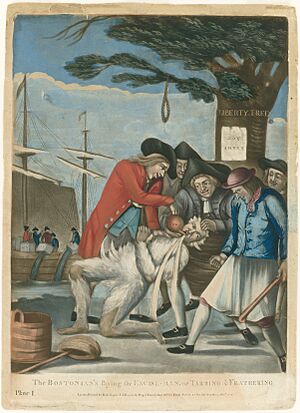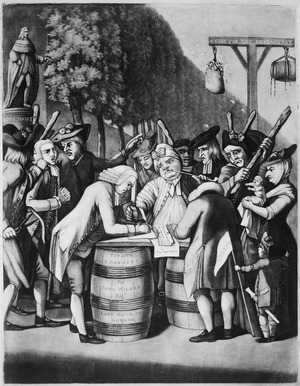Tarring and feathering facts for kids
Tarring and feathering was a harsh public punishment. It involved removing some of a person's clothing. Then, sticky tar was put on their skin. After that, feathers were thrown onto them or they were rolled in feathers. The feathers would stick to the tar. This punishment was used to shame people publicly. It was a way to show strong disapproval for someone's actions. People used it to enforce their own idea of justice. This happened in medieval Europe and in European colonies. It was also seen in the early American frontier. It was often a form of vigilante justice, meaning people took the law into their own hands. The idea of someone being tarred and feathered still means they faced very strong public criticism. This punishment was quite common in British colonies in North America. This was especially true between 1766 and 1776. A well-known case in America was that of John Malcolm. He was a British official during the American Revolution.
Early History of Tarring and Feathering
The earliest record of tarring and feathering comes from 1189. Richard I of England, also known as Richard the Lionheart, gave orders for his navy. These orders stated that a thief, if found guilty, would have their head shaved. Then, sticky tar and feathers would be put on their head. This was so everyone would know they had committed a crime. The person would then be left at the first port they reached.
Tarring and Feathering in 18th-Century North America
The practice of tarring and feathering became more common in the Americas. This was especially true in the mid-1700s. During the 1760s, people used it to protest the Townshend Revenue Act. This act placed new taxes on the American colonies. People also used it against those who tried to enforce the taxes. After a quiet period, the Tea Act in May 1773 led to more incidents.
See also
 In Spanish: Emplumar para niños
In Spanish: Emplumar para niños



